Flight Behavior
Air Date: Week of November 9, 2012
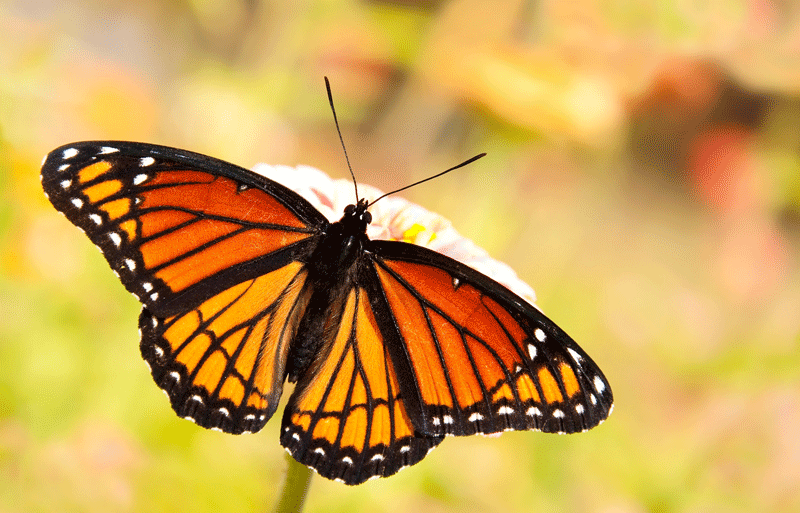
Female monarch butterfly (Danaus plexippus)(Bigstockphoto.com)
Best selling author Barbara Kingsolver’s newest novel takes place in a small Appalachian community in rural Tennessee. The farming town gets international attention when climate change causes the unexpected arrival of a huge collection of beautiful winged creatures. Barbara Kingsolver talks with host Steve Curwood.
Transcript
CURWOOD: Award-winning author Barbara Kingsolver has written more than a dozen books, including The Bean Trees, The Poisonwood Bible, and Prodigal Summer. We talked to her back in 2007 about "Animal, Vegetable, Miracle" -- the true story of moving her family from Arizona to Virginia and pledging to eat only locally grown food for a year. Well, Barbara Kingsolver’s newest novel, Flight Behavior, is also set in Appalachia, in Tennessee. Barbara, thanks for coming back here to tell us about it!
KINGSOLVER: Thanks, it's great to be back here!
CURWOOD: Well, first off, how are things on the farm? I understand you’re still living in – what is it? – Western Virginia? and eating only whatever it is that you and your neighbors can grow?
KINGSOLVER: Southwestern Virginia, right. Regionally we’re in southern Appalachia. There are a lot of farms around us, and so, yes, we really have no trouble at all surviving on locally produced food.
CURWOOD: And so, you raise sheep, you have…

Barbara Kingsolver (Photo: David Wood)
KINGSOLVER: We raise sheep for both wool and meat, and we have a large vegetable garden, but so do almost all of the people around us.
CURWOOD: Well, I have to say that your latest book: Flight Behavior, starts of, well, it’s kind of mysterious. Your protagonist, Dellarobbia, is headed off into the woods, it’s a back lot on her Tennessee sheep farm, and she’s on her way to meet a man and have an affair! She’s going to give up her kids, she’s going to give up all of that farm life, but then she sees something that makes her change her mind. Can you tell us about that?
KINGSOLVER: Yes. She’s marching up this mountain, she’s at the end of this rope, she doesn’t really want to wreck her life but she has to wreck her life. She’s stopped along the way at the sight of what looks to her like a valley of trees on fire. These trees are all glowing orange. And, she becomes convinced that it’s a miracle, it’s like her burning bush, and she turns around and runs back down the hill, picks up her kids and decides to straighten up her life. Well, soon enough she finds, it’s not a miracle, it’s a freakish biological event caused most likely by climate change… and I hate to give away what it is, but…
CURWOOD: So, final warning here, turn the radio down for a few minutes and come back if you want to be surprised.
KINGSOLVER: Spoiler alert!
CURWOOD: Otherwise, go ahead, tell us what it was…
KINGSOLVER: It’s an immense congregation of Monarch butterflies. Normally, these butterflies congregate, aggregate for the winter in the high mountains of central Mexico. In this case, I imagined a circumstance in which their migratory system is so disrupted that they would shift their aggregation to very similar mountains in southern Appalachia. What would happen if this happened is it would be touch and go because this is a much colder winter in southern Appalachia. And most likely what is going to happen in the course of this winter is the whole species is going to freeze to death.
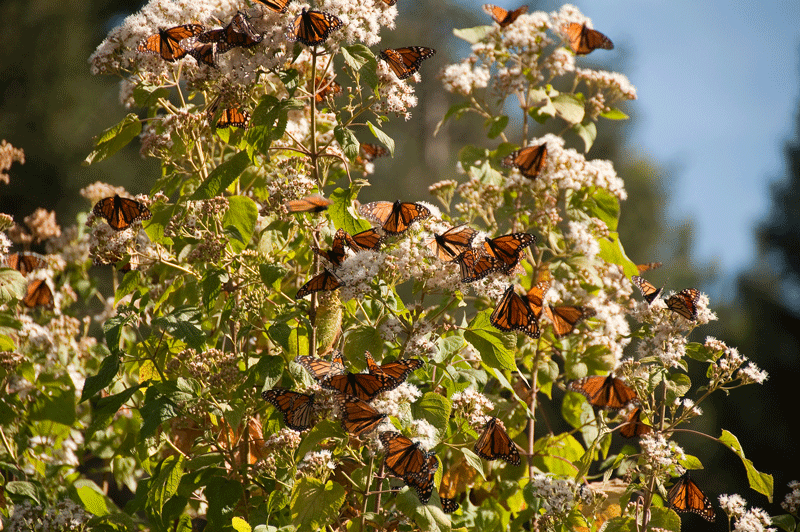
Butterflies congregate at the Michoacán butterfly reserve in Mexico. (Bigstockphoto.com)
CURWOOD: So, of course, you, Barbara Kingsolver, you’ve trained deeply in science…
KINGSOLVER: I have a Bachelor of Science, a Master’s in Ecology and Evolutionary Biology, and actually, I was in a PhD program… I got… I did everything but finish the dissertation, I defected at the last minute when I sort of realized that this dissertation, if I finished it, would probably reach and impress - maybe 11 or 12 people in the world. And I had this idea I could shoot for an even bigger audience than that.
CURWOOD: In this novel, Flight Behavior, you spend a lot of time on science. It may be a fiction that the Monarchs are taking up residency in Tennessee, but after that all of the science that you have in there, to my read, is accurate.
KINGSOLVER: Thank you.
CURWOOD: Tell me more about the science of these Monarch butterflies and why you used this as a teaching tool for Dellarobbia and the people around her.
KINGSOLVER: I just had this vision of the Monarchs roosting in an Appalachian hollow. That’s sort of the magic of writing a novel is 99 work and one percent magic. But I recognized immediately that it would be a really great prime mover for a novel because there is so much truth, already. There are plenty of well-documented circumstances in which animals that are less adaptable than we are are getting shifted in ways that are both incongruous and fatal to them.
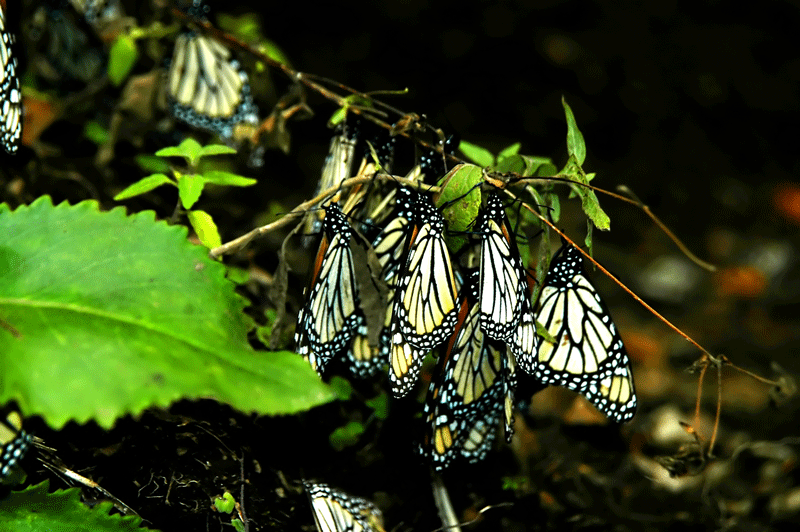
Hibernating monarch butterflies. (Bigstockphoto.com)
At one point, Dellarobbia in this novel is trying to explain what she has learned, because she comes to be, actually, in the employ as sort of a low-level lab tech for this scientist who comes in to study this. So, she’s sort of learning all this stuff and she’s trying to translate it into terms that her friends and her poor husband, Cub – he’s kind of a dim bulb, he’s not very bright, but he’s very sweet – she’s trying to explain it and she says, ‘it’s like they’re directed by cues that they can’t change - they have to follow the signs.’
So, she says ‘it’s like if you followed the signs to the grocery store every week, and you went to the Food King. And then one day you followed the same signs exactly the same way and you ended up at the auto parts store, what would you eat?’
CURWOOD: The science around these Monarch butterflies is really fascinating. That they make these generational migrations, for instance, can you tell us more about that?
KINGSOLVER: It’s something to knock your socks off. The Monarch is in your yard, in the fall, maybe in Connecticut or Maine or Minnesota… that Monarch that is about to turn around and head for Mexico – has never been in Mexico. Its parents were never in Mexico.
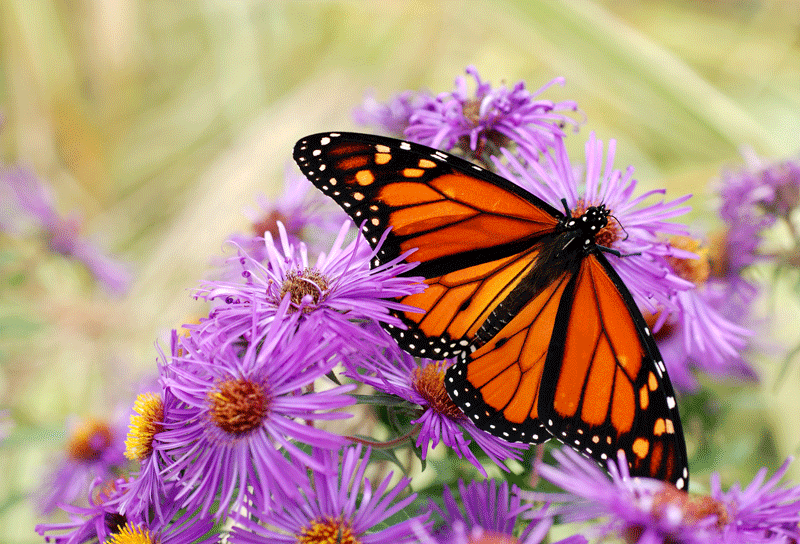
Male monarch butterfly (Danaus plexippus) (Bigstockphoto.com)
So, if you picture this as a big circle, the Monarchs that spend the winter in Mexico, on those high, cool mountains, suddenly wake up in March, they go crazy in this mating frenzy, and the females head for dear life towards Texas, towards the first unfurling milkweed plants in what’s called the spring range across southern Texas. They get there just in time to lay eggs and die.
Then the next generation hatches, eats those milkweed leaves, flies a little further north, sort of where spring is coming and where milkweeds are coming up across the southern tier of the United States. They die, those eggs hatch into butterflies that fly even further north, all the way up into Canada. They die, and then their offspring go back to Mexico. How does a brain the size of a pinhead tell them how to get some place they’ve never been – year after year, century after century – they’ve been doing this for thousands of years. And now, suddenly it is getting disrupted.
Not precisely as I’ve portrayed it in this novel, but that is a potentially real scenario. I tracked down, I did a lot of research on Monarchs, obviously, and I tracked down the world’s foremost experts, notably Dr. Lincoln Brower, and I laid this scenario on him, and I was afraid he would laugh me out of the laboratory. But no! I said… ‘is this at least plausible?’ And he said, ‘yes it is, and lets talk about why and how that could be true.’
CURWOOD: And is that when you walked out of his lab feeling really sad?
KINGSOLVER: Yes and no. I knew when I entered this novel, how serious this is. How far along this scary road we have gone. There’s a moment in this novel when Ovid is trying to explain to the reporter how bad things are, he says: ‘We are perched at the top of Niagara falls, we can’t just take a leisurely swim back upstream when we get over our denial. Does this strike you,’ he asks, ‘as a good time to be debating the existence of the falls?’
I know where we are, I’ve been following this a long time. I’m a scientist, I believe science. I guess it makes me feel a little better to know I’m talking about it, I’m not in denial. I’m doing the best I can to encourage a conversation and maybe illuminate some of the reasons why we’re failing to converse. That’s the best I can hope for.
CURWOOD: So, let’s talk a little bit about your protagonist here, Dellarobbia, she got into this marriage that she was going to throw away, well, it was a shotgun wedding.
KINGSOLVER: Right. Well, whatever big ideas she might have had about her life in high school, she gave up when she got pregnant and married at 17. So she’s very constrained by her circumstances. So, this event brings Dellarobbia, for the first time, in contact with journalists from the outside world, with tourists, with scientists, and really with science. With a scientific way of evaluating what she sees.
CURWOOD: Now there’s a great example in your book that I think really exemplifies the different camps that people fall into when it comes to believing in climate change. It starts on page 320, Dellarobbia is talking to Ovid, the butterfly scientist… could you read that for us please?
KINGSOLVER: Sure. He says, “Science doesn’t tell us what we should do, it only tells us, what is.” And Dellarobbia responds, “well, that must be why people don’t like it.” Ovid seems startled, “they don’t like science?” “I’m sorry, I’m probably speaking out of turn here, you’ve explained to me how big this is, the climate thing. That it’s taking out things we’re counting on, but people are saying, ‘just forget it.’ My husband, guys on the radio, they say it’s not proven.”
Ovid says, “What we’re discussing is clear and present, Dellarobbia, scientists agree on that. These men on the radio, I assume are non-scientists. Why would people buy snake oil when they want medicine?” “That’s what I’m trying to tell you. You guys aren’t popular. Maybe your medicine is too bitter. Or you’re not selling to us. Maybe you’re writing us off thinking we won’t get it.”
Ovid nodded slowly, “We were not always unpopular, scientists. 15 years ago people knew about global warming, at least in a general way, you know,” he said, “In surveys they would all answer: Yes it exists, it’s a problem. Conservatives or liberals, exactly the same. Now there is a divide.”
“Well, yeah,” Dellarobbia says, “People sort themselves out, like kids in a family, you know? They have to stake out their different territories, the teacher’s pet or the rascal. I’d say the teams get picked and then the beliefs get handed around. Team camo, we get the right to bear arms and John Deere and the canning jars and tough love and taking care of our own. The other side wears, I don’t know what, something expensive. They get recycling and population control and lattes and as many second chances as anybody wants.” Dr. Byron looked stupefied.
CURWOOD: Dellarobbia is a character I find just fascinating. People who would like to sell a lot of books in America typically don’t write about really poor people. And Dellarobbia is pretty close to the bottom; I mean, she’s struggling to even buy her kids presents for Christmas in the dollar store.
KINGSOLVER: You’re right. Poverty is an important part of the grounding of this novel, and this is the culture I wanted to describe and then move you into a conversation with yourself about environmentalism. And I think the environmental movement in this country, and in the world, may often been failing to take into account class.
CURWOOD: Indeed! Because, you have this scene a bit later, she’s with an activist who’s come to her farm, he’s handing out leaflets and he’s trying to get people to reduce their carbon footprint, but it turns out she’s doing just about everything that’s on her list.
KINGSOLVER: It’s completely irrelevant to her life. I mean, he goes down this checklist that starts with: ‘Take your own silverware when you dine out,’ and she says, ‘I haven’t been to a restaurant in over two years.’ And that restaurant being the Dairy Queen or something. And he says, ‘Well, OK, eat less red meat,’ and she sort of wishes she could eat red meat.
And he says, ‘Turn down the thermostat,’ and she’s trying to keep the electricity on in her house. It’s been shut off several times already during this novel because she couldn’t pay the bills. This is a moment when she is beginning to get that as humans on this earth, we’ve passed some kind of point where we’re going to have to start to rein ourselves in. Rein in our consumption, and she’s seeing that she never got there in the first place. This is what a lot of people on Planet Earth are being asked to do: rein themselves in when they never quite got there in the first place.
CURWOOD: Well, I guess we don’t want to give away the ending here…
KINGSOLVER: We don’t!
CURWOOD: We can’t say whether the butterflies might survive this Tennessee winter or Dellarobbia would want to stay on the farm…
KINGSOLVER: We cannot. We cannot!
CURWOOD: So instead I think I need to ask you, Barbara Kingsolver, what do you do next? Can we expect more works on the environment? Climate change?
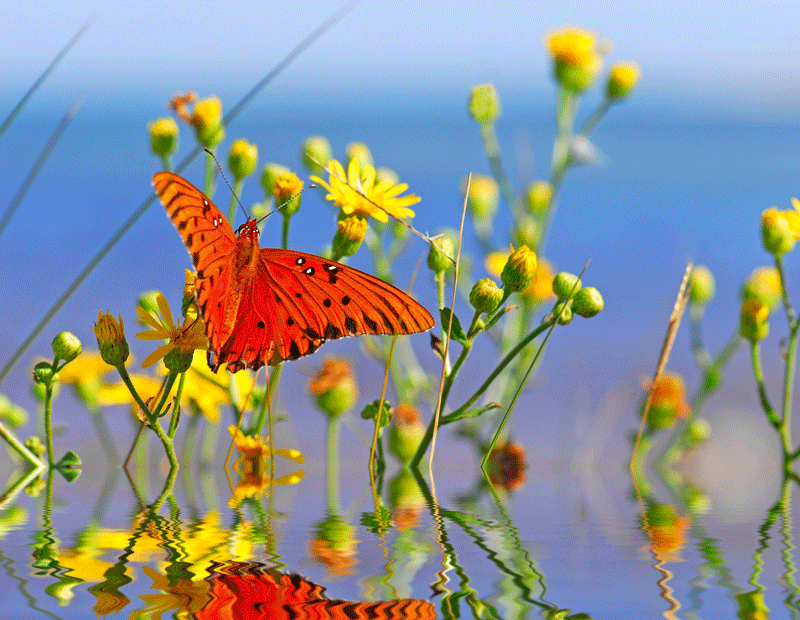
(Bigstockphoto.com)
KINGSOLVER: I think you can. I think you can expect that I will always write about things that seem to matter to me and to matter to my readers because a novel is an audacious act. I’m asking you: OK, set aside your life for 8 or 10 hours and listen to me. I come from a culture of modesty. We southerners don’t say, ‘Sit down and listen to me.’ We say, ‘What do you think of this?’ I promise you, I’m not going to ask you to give yourself over to a whole novel unless it’s going to rattle at the cage of humans on the world a little bit. So that’s what you can expect of me.
CURWOOD: Barbara Kingsolver’s latest book is entitled Flight Behavior. Thank you so much for taking this time today!
KINGSOLVER: Thanks so much, it’s great to be here.
Links
Living on Earth wants to hear from you!
Living on Earth
62 Calef Highway, Suite 212
Lee, NH 03861
Telephone: 617-287-4121
E-mail: comments@loe.org
Newsletter [Click here]
Donate to Living on Earth!
Living on Earth is an independent media program and relies entirely on contributions from listeners and institutions supporting public service. Please donate now to preserve an independent environmental voice.
NewsletterLiving on Earth offers a weekly delivery of the show's rundown to your mailbox. Sign up for our newsletter today!
 Sailors For The Sea: Be the change you want to sea.
Sailors For The Sea: Be the change you want to sea.
 The Grantham Foundation for the Protection of the Environment: Committed to protecting and improving the health of the global environment.
The Grantham Foundation for the Protection of the Environment: Committed to protecting and improving the health of the global environment.
 Contribute to Living on Earth and receive, as our gift to you, an archival print of one of Mark Seth Lender's extraordinary wildlife photographs. Follow the link to see Mark's current collection of photographs.
Contribute to Living on Earth and receive, as our gift to you, an archival print of one of Mark Seth Lender's extraordinary wildlife photographs. Follow the link to see Mark's current collection of photographs.
 Buy a signed copy of Mark Seth Lender's book Smeagull the Seagull & support Living on Earth
Buy a signed copy of Mark Seth Lender's book Smeagull the Seagull & support Living on Earth

